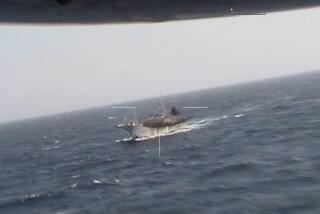Anglers Ignoring the Bait : There Are Fish Aplenty in Southland Waters, but Where Are the Takers?
- Share via
SAN DIEGO — The boat slows, then gradually turns--it’s the signal everybody has been awaiting. Scrambling out of the galley and onto the deck, the passengers reach into the tanks and grab sardines. Baiting their hooks with the small and slippery fish, they cast and wait.
Line spins from one reel, then another. Soon, nine anglers are fighting fish, their rods bent over the rail, their reels screaming. The deck becomes a running board for those trying to maintain the appropriate angle on their fleeing quarry, to keep their lines straight and tight.
“Let him through,” one deckhand shouts to an idle fisherman, guiding a busy one toward the bow. Two others are already there, where another deckhand stands ready with a 12-foot gaff.
“Fresh fish on the rail!” shouts the captain, himself ready with another gaff in the middle of the stern.
The fish is the third or fourth fought almost in succession by Carrie Friedman. It hits the deck after a 15-minute fight and she complains of tired arms to her husband. “Catch another one and work it out,” he replies jokingly while struggling with one of his own.
Other fish begin to hit the deck, where they are picked up and hastily shoved into bags. The crew is working furiously to keep up; the cook emerges from the galley to offer his assistance.
“We all consider ourselves deckhands,” the skipper says.
The shout, “Color!” indicates another fish near the surface, its silvery silhouette circling below as it resists with all its waning strength. Eventually, it is plucked from the water and plopped onto the deck.
Another is stuck with the gaff and hauled over the rail, soon winding up like all the rest--stuffed head-first in a gunny sack.
This overcast day aboard the 60-foot Conquest is nearing an end.
Joe Chait, 29, owner and operator of the Conquest, which runs out of Fisherman’s Landing, will radio his count back: 46 yellowtail, 25 dorado and 31 skipjack tuna. These totals are a bit better than most, but Chait had traveled farther south--86 miles from Pt. Loma.
Torrance resident Philip Friedman, whose 976-TUNA company chartered the Conquest, will take the jackpot money with the 35-pound dorado he caught on the boat’s first stop, the fish’s brilliant green and blue colors having since turned a pale yellow.
The yellowtail are big--averaging about 20 pounds--compared to those generally caught in offshore waters, and thus are particularly strong and meaty. The dorado are more plentiful than they have been in years, if not decades.
Such catches as Chait’s are typical of any day this summer, one of the most consistent seasons in years for the overnight fishing fleet.
“We’ve been fishing kelp paddies since April,” Chait says. “But as the water warmed up, we’ve gotten more of the tuna and dorado that have moved into our area on the kelp paddies. We’re hoping the bite just keeps on rollin’ here.”
And for the most part it has.
But strangely enough, one could not tell this was the case by boarding an open-party boat and finding it mainly empty space. You can’t even get a decent tangle going with your neighbor, the loads are so light. Foot-stomping is at a minimum, elbow room at a maximum.
John Shull, owner and operator of the Pacific Dawn, comes to Fisherman’s Landing from Oxnard each summer to carry his regular charters and, when he has no charters, to carry customers paying between $80 and $100 to board any boat available.
There have been several days when his 60-foot boat has carried less than a dozen customers.
Business has not kept pace with the fishing.
“As far as fish go, we’ve had a tremendous season,” says Phil Lobred, general manager of H&M; Landing. “Yellowtail fishing has been incredibly good. Exotics are here. You judge a season by the fishing, but when you ask me about the season, I judge it as to how many people we’ve carried, and I would say it’s been mediocre at best.
“Tonight my three open-party boats--each one is half full . . . in the middle of August. I not only should be running those boats completely full, I ought to be scrambling for any (boat) I can get my hands on to run in an overflow, open-party and limited-load capacity.”
Chait tells of the 66-pound bigeye tuna one of his passengers boated recently, and of the time earlier this month when the crew baited and caught a 356-pound swordfish after a surprisingly short fight of just less than two hours.
“It was that fish’s day to die, that’s all there is to it,” he says. “You just don’t get a fish at 356 pounds in 1:55.”
Chait and his crew did. The broadbill was sectioned into meaty steaks and given away.
“We had a stop once where we had six marlin hooked up at one time,” Chait continues. “We had five other marlin hooked and they were all jumping in different directions, and we couldn’t go anywhere. We had everybody wired up on marlin, and the bluefin showed right on the corner (of the stern). We got two of the five (marlin) and we got a good stop on the bluefin once we broke off on the marlin.”
His crew witnessed the passing of a pod of blue whales, nature’s largest mammals, moving majestically in the distance. “They were 100 feet long,” Chait says. “We caught tuna trolling around them.”
Shull, 32, talks regularly of the fast action associated with the tuna that migrate up the Baja coast this time of year. It’s the main reason he comes here to work for the summer.
“We had one stop on bluefin tuna that lasted two hours,” he said of one of his recent trips. Bluefin tuna are one of the ocean’s strongest swimmers. Many of those being taken by passengers aboard San Diego’s overnight fleet weigh about 50 pounds.
The area called the outer banks continue to hold yellowfin and bigeye tuna, as well as the bluefin. So why is business not what it should be?
Longtime skipper Buzz Brizendine once said business is good as long as the fish being caught begin with a “t” and end with an “a”--as in tuna, and that may be the case. But business is best when that tuna is albacore.
“No matter what they’re catching in L.A., if we have albacore, we have a bonanza season,” Lobred says. “It’s like Disneyland in the summer, every night (at the landings). If we’re catching ‘em, we have so many fishermen that we couldn’t house enough boats around here. Without ‘em, it’s touchy.”
The last five years have been touchy for many boat owners here because albacore--except for a modest appearance last season--have not made any significant showing. The landings here were sometimes operating at as low as 20% capacity.
Commercial fishing was blamed for the decline of albacore. Experts pointed out that, historically, albacore have shown in cycles and that stocks were still in good shape.
In any case, business remains a struggle for many boat owners when albacore do not show. The longfin tuna are currently creating a stir at the landings, showing more frequently in the fish counts each day.
But Los Angeles area fishermen--who make up about 75% of San Diego’s sportfishing business--have grown wary over the years with the sporadic nature of such appearances and will likely wait and watch.
“There is no better attraction to the people than good, steady albacore fishing,” Chait said. “It really draws the people.”
But Chait also points to the options available this season and says prospective fishermen face high prospects with or without the more popular albacore.
“We would love to have albacore, but we do have a pretty good substitute here: Nice-size yellowtail, dorado, some bluefin and some yellowfin.”






